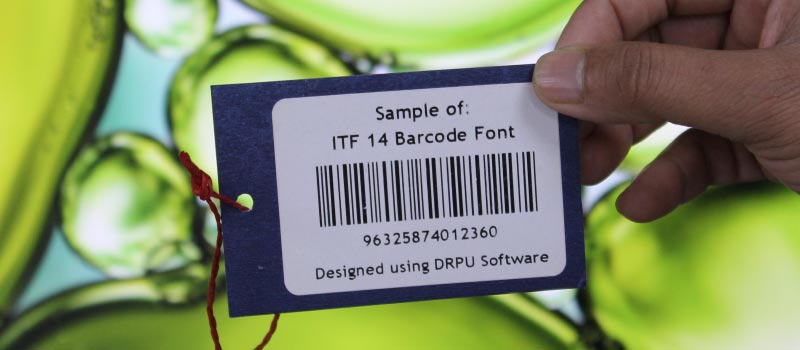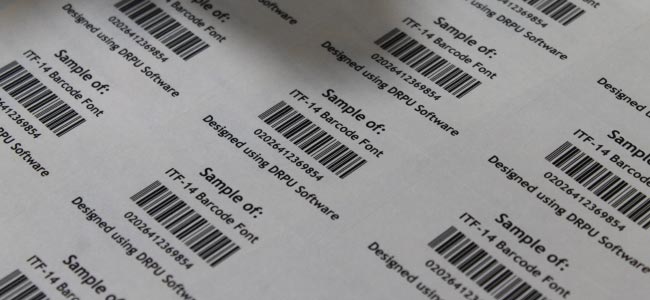Introduction of ITF-14 Barcode

-
The ITF-14 barcode is a type of Interleaved 2 of 5 (ITF) barcode, which is a high-density barcode that encodes pairs of digits in a sequence of bars and spaces. The ITF-14 barcode consists of a series of vertical bars and spaces, with each bar and space representing a binary number (0 or 1). The barcode is read by a barcode scanner, which decodes the barcode into the 14-digit GTIN.
-
The ITF-14 barcode is used primarily for labelling shipping containers and pallets that contain multiple units of a product. The barcode is usually printed on a label or sticker that is affixed to the outside of the container or pallet. The barcode contains information about the product, including the product's GTIN, the quantity of units in the container or pallet, and the country of origin.
-
The ITF-14 barcode is also important for product tracking and inventory management. By scanning the barcode, retailers and manufacturers can track the movement of a product through the supply chain and monitor inventory levels. This helps to ensure that products are in stock when customers need them and helps to prevent stockouts and overstocking.
-
The ITF-14 barcode is an important tool for retailers and manufacturers because it helps to streamline the shipping and receiving process. By scanning the barcode, retailers and manufacturers can quickly and accurately identify the contents of a container or pallet and verify that they have received the correct quantity of units. This helps to reduce errors and delays in the supply chain, which can save time and money for both retailers and manufacturers.
-
In order to create an ITF-14 barcode, a company must first obtain a GTIN from a GS1 Member Organization. The GTIN is a unique identification number that is assigned to a product and is used to generate the ITF-14 barcode. The barcode can be generated using a barcode software program or online barcode generator, and can be printed on a label or sticker using a thermal transfer or direct thermal printer.
In conclusion, an ITF-14 barcode is a 14-digit barcode derived from the GTIN that is used to label shipping containers and pallets containing multiple units of a product. The barcode is read by a barcode scanner and contains information about the product, including the product's GTIN, the quantity of units in the container or pallet, and the country of origin. The ITF-14 barcode is an important tool for retailers and manufacturers because it helps to streamline the shipping and receiving process, track product movement through the supply chain, and manage inventory levels.
Recent Blogs
-
EAN 8 Barcode System
Written By: Digital Deeper | 06/05/2023
-
Industrial 2 of 5 Barcode
Written By: Tech Solution | 06/05/2023
-
Code 39 Barcode
Written By: Digital Deeper | 04/05/2023
-
Full ASCII Barcode
Written By: Tech Solution | 03/05/2023
-
CODE 128 SET C
Written By: Teachable Tech | 04/05/2023
Structure of ITF-14 Barcode
The ITF-14 barcode is a type of Interleaved 2 of 5 (ITF) barcode that is used to label and track products as they move through the supply chain. The ITF-14 barcode is a 14-digit barcode that is derived from the Global Trade Item Number (GTIN), which is a unique identification number assigned to a product. In this section, we will discuss the structure of an ITF-14 barcode in detail.

➜The ITF-14 barcode consists of a series of vertical bars and spaces that represent a binary number (0 or 1). The barcode is divided into four sections: the quiet zone, the guard bars, the data bars, and the checksum digit.
-
Quiet Zone:
The quiet zone is a clear area located on both sides of the barcode. The quiet zone is essential to ensure that the barcode scanner can read the barcode correctly. The quiet zone must be at least 9 times the width of the narrowest bar or space in the barcode.
-
Guard Bars:
The guard bars are two sets of three bars that protect the barcode from being misread. The guard bars are located at the beginning and end of the barcode and are always the same pattern of bars (101). The guard bars are essential to ensure that the barcode scanner can identify the start and end of the barcode.
-
Data Bars:
The data bars are the series of bars and spaces that represent the GTIN. The data bars are divided into three sections: the left-hand quiet zone, the leading digit, and the data characters. The left-hand quiet zone is a clear area that ensures that the barcode scanner can read the leading digit correctly. The leading digit is always "0" and is used to identify the barcode as an ITF-14 barcode. The data characters represent the 13-digit GTIN and are encoded using pairs of bars and spaces. Each pair of bars and spaces represents a number from 0 to 9.
-
Checksum Digit:
The checksum digit is the last digit in the barcode and is used to verify that the barcode has been read correctly. The checksum digit is calculated based on the 13-digit GTIN using a formula known as the Modulo 10 algorithm. The Modulo 10 algorithm assigns a weight to each digit in the GTIN and calculates a checksum digit that is used to verify the integrity of the barcode.
In summary, the ITF-14 barcode is a 14-digit barcode that is derived from the GTIN and is used to label and track products as they move through the supply chain. The barcode consists of a series of vertical bars and spaces that represent a binary number (0 or 1) and is divided into four sections: the quiet zone, the guard bars, the data bars, and the checksum digit. The quiet zone is a clear area located on both sides of the barcode, the guard bars protect the barcode from being misread, the data bars represent the 13-digit GTIN, and the checksum digit is used to verify the integrity of the barcode.
Applications of ITF-14 Barcode
The ITF-14 barcode has several applications across various industries. In this section, we will discuss the applications of ITF-14 barcode in detail.
-
Retail Industry:
The retail industry is one of the primary users of the ITF-14 barcode. Retailers use the ITF-14 barcode to label products and track inventory as they move through the supply chain. The barcode enables retailers to track the movement of products from the manufacturer to the warehouse and ultimately to the store. The ITF-14 barcode also enables retailers to manage their inventory more efficiently by providing accurate and real-time information about product availability and stock levels.
-
Food Industry:
The food industry uses the ITF-14 barcode to label food products and track them as they move through the supply chain. The barcode enables food manufacturers and distributors to track the movement of food products from the farm to the processing plant, to the warehouse, and ultimately to the grocery store. The barcode also enables food manufacturers and distributors to manage their inventory more efficiently, ensuring that food products are available when and where they are needed.
-
Manufacturing Industry:
The manufacturing industry uses the ITF-14 barcode to track raw materials, work-in-progress, and finished goods. The barcode enables manufacturers to track the movement of materials and products through the production process, ensuring that they are used efficiently and effectively. The barcode also enables manufacturers to manage their inventory more efficiently, ensuring that they have the materials and products they need to meet customer demand.
-
Logistics Industry:
The logistics industry uses the ITF-14 barcode to label and track shipments as they move through the supply chain. The barcode enables logistics providers to track the movement of shipments from the warehouse to the transportation provider and ultimately to the destination. The barcode also enables logistics providers to manage their inventory more efficiently, ensuring that shipments are delivered on time and in the correct quantities.
-
Healthcare Industry:
The healthcare industry also uses the ITF-14 barcode to track medical devices, equipment, and supplies. The barcode enables healthcare providers to track the location and usage of medical devices and supplies, ensuring that they are used correctly and efficiently. The barcode also enables healthcare providers to manage their inventory and restock supplies as needed.
-
Government Agencies:
Government agencies also use the ITF-14 barcode to track and manage assets and inventory. The barcode enables government agencies to track the location and usage of assets such as equipment, vehicles, and supplies. The barcode also enables government agencies to manage their inventory more efficiently, ensuring that they have the resources they need to carry out their mission.
➽In summary, the ITF-14 barcode has several applications across various industries, including retail, healthcare, food, manufacturing, logistics, and government agencies. The barcode enables organizations to label and track products and assets, manage inventory more efficiently, and improve supply chain visibility and efficiency. The use of ITF-14 barcode has become an essential tool in modern-day logistics and supply chain management, which helps companies streamline their operations and improve their bottom line.
📅 Published Date: 04/05/2023